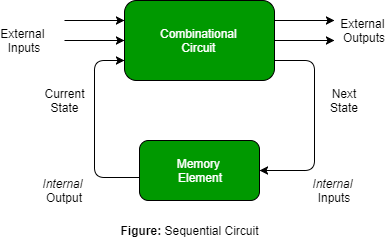Principles in Digital System Design
Last Updated :
31 Jul, 2023
We are living in a world where we are surrounded by computational going all around and devices connected to the internet to what we refer to as IoT(Internet of Things). Even our IoT devices are changing so rapidly these days with the technology stack of machine learning and artificial intelligence. It is because of digital systems. Digital systems consist of digital circuits that process data physically stored in binary format. Now we do have certain principles in system design in order for designing digital systems.
- Digital systems are fast.
- Digital systems are accurate.
- Digital systems consume less power.
Digital principles in system design invoke the study of different concepts, and techniques used in designing digital systems.
Goal Of Design Systems: It is to be a single source of truth for the product( or say organization) . In order to achieve that designers and developers need to collabrate as they both have to speak same language. Gradually they start improving the collabration process for product to get designed. Everyone (designers and developers) comes on a single designers and developers.
How to Design a Digital System?
Digital systems are synonyms to binary systems where we are dealing with 0’s and 1’s. Operations are carried this digital data known as boolean algebra where Gates are used to manipulate this information such as AND, OR, and XOR. Now here we just do plot gates as while designing we need to take care of cost and other factors corresponding to which we do have various design patterns over here such as combinational, sequential, and various others design patterns that are there just with tweaks made out in positioning gates while designing.
Remember: Digital circuit is formed by combination of 2 or more than 2 logical gates.
Now we will be listing out principles that are to be followed while designing digital systems as follows:
List of Principles in Designing Digital Systems:
Boolean algebra is a branch of mathematics that deals with the computational logic of digital circuits. It helps us in easing out digital circuits.
They are building blocks for any digital circuits, they are building blocks for any digital circuits.
It is a process/technique of designing digital systems that perform a specific operation based on the input provided. Combinational logic gates are used in these systems to modify the inputs and produce the desired outputs.

The steps involved in combinational logical design are briefly described below are as follows:
- Understanding the requirements
- Truth Table
- Logic Expressions
- Simplification
- Gate level design
- Circuit Diagram
- Implementation and Testing
- Optimization and Documentation
Note: For more information in order to understand the construction of Combinational Circuits please refer here.
4. Sequential Logic Design:
The process of creating digital circuits or systems with memory that can store and process information over time is known as sequential logic design. Sequential logic uses feedback and the present state of the system to predict future behavior, in contrast to combinational logic, which just considers the current inputs. Combinational logic gates are used in these systems to modify the inputs and produce the desired outputs. The procedures involved in combinational logical design are briefly described below.
The steps involved in combinational logical design are briefly described below are as follows:

- Design the specification
- State diagram
- State Encoding
- Next state Logic and Output logic
- Memory elements
- Circuit Diagrams
- Implementation and Testing
- Optimization and Documentation
Tip: It is recommended to have good knowledge of differences between combinational and sequential circuits.
5. Integrated Circuit Design:
The process of developing electrical circuits that are compacted and integrated onto a single semiconductor chip is known as integrated circuit (IC) design. It entails creating the component’s internal structure, relationships, and functioning.
The steps involved in combinational logical design are briefly described below are as follows:
- Specification and Archietecture
- Logical Design
- Circuit Design
- Physical Design
- Verification
- Manufacturing and Fabrication
- Testing and Characterization
- Packaging and Integration
6. Microprocessor and Computer Architecture:
The microprocessor is an important part of a computer architecture without which you will not be able to perform anything on your computer. It is a programmable device that takes in input performs some arithmetic and logical operations over it and produces the desired output. In simple words, a Microprocessor is a digital device on a chip that can fetch instructions from memory, decode and execute them, and give results
7. Digital System Testing and Verification:
Testing in a digital system is computed with reconciliation with the utmost
8. Timing and Synchronization:
Timing and synchronization are important considerations when developing systems, especially digital systems where event sequencing and coordination are key. Here are some crucial ideas and methods for synchronization and timing in system design.
- Clock Signal
- Clock Domain Crossing
- Timing Analysis
9. System Integration and Interfacing:
System Integration is combining components to form a cohesive digital system, while Interfacing establishes connections for seamless communication between subsystems.
10. Power and Signal Integrity:
Power Integrity mainly focuses on ensuring Power Distribution Network (PDN) are as follows:
Specific design techniques are as follows:
- Proper Decoupling Capacitor Placement
- Impedance Control
- Power Plan Design
Objectives of Digital Systems:
- Using boolean functions we are able to design digital systems.
- They help us in designing combinational circuits.
- They help us in analyzing synchronous and asynchronous communication: With the help of digital systems we get to analyze
- Understanding Programmable Logic Devices (PLDs): We overcome ASIC(Application Specific Integrated Circuits) in order to overcome we have PLDs As in the case of ASIC we had 2 complex connections that were taking up more space. With the help of PLD, we can design combinational and sequential circuits. PLD is a special type of IC programmable by the user.
Share your thoughts in the comments
Please Login to comment...